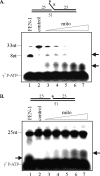Long patch base excision repair in mammalian mitochondrial genomes
- PMID: 18635552
- PMCID: PMC2546560
- DOI: 10.1074/jbc.M803491200
Long patch base excision repair in mammalian mitochondrial genomes
Abstract
The mitochondrial genome is highly susceptible to damage by reactive oxygen species (ROS) generated endogenously as a byproduct of respiration. ROS-induced DNA lesions, including oxidized bases, abasic (AP) sites, and oxidized AP sites, cause DNA strand breaks and are repaired via the base excision repair (BER) pathway in both the nucleus and mitochondria. Repair of damaged bases and AP sites involving 1-nucleotide incorporation, named single nucleotide (SN)-BER, was observed with mitochondrial and nuclear extracts. During SN-BER, the 5'-phosphodeoxyribose (dRP) moiety, generated by AP-endonuclease (APE1), is removed by the lyase activity of DNA polymerase gamma (pol gamma) and polymerase beta in the mitochondria and nucleus, respectively. However, the repair of oxidized deoxyribose fragments at the 5' terminus after strand break would require 5'-exo/endonuclease activity that is provided by the flap endonuclease (FEN-1) in the nucleus, resulting in multinucleotide repair patch (long patch (LP)-BER). Here we show the presence of a 5'-exo/endonuclease in the mitochondrial extracts of mouse and human cells that is involved in the repair of a lyase-resistant AP site analog via multinucleotide incorporation, upstream and downstream to the lesion site. We conclude that LP-BER also occurs in the mitochondria requiring the 5'-exo/endonuclease and pol gamma with 3'-exonuclease activity. Although a FEN-1 antibody cross-reacting species was detected in the mitochondria, it was absent in the LP-BER-proficient APE1 immunocomplex isolated from the mitochondrial extract that contains APE1, pol gamma, and DNA ligase 3. The LP-BER activity was marginally affected in FEN-1-depleted mitochondrial extracts, further supporting the involvement of an unidentified 5'-exo/endonuclease in mitochondrial LP-BER.
Figures





Similar articles
-
DNA base excision repair activities and pathway function in mitochondrial and cellular lysates from cells lacking mitochondrial DNA.Nucleic Acids Res. 2004 Apr 23;32(7):2181-92. doi: 10.1093/nar/gkh533. Print 2004. Nucleic Acids Res. 2004. PMID: 15107486 Free PMC article.
-
Removal of oxidative DNA damage via FEN1-dependent long-patch base excision repair in human cell mitochondria.Mol Cell Biol. 2008 Aug;28(16):4975-87. doi: 10.1128/MCB.00457-08. Epub 2008 Jun 9. Mol Cell Biol. 2008. PMID: 18541666 Free PMC article.
-
Physical and functional interaction between human oxidized base-specific DNA glycosylase NEIL1 and flap endonuclease 1.J Biol Chem. 2008 Oct 3;283(40):27028-37. doi: 10.1074/jbc.M802712200. Epub 2008 Jul 28. J Biol Chem. 2008. PMID: 18662981 Free PMC article.
-
Enzymology of mitochondrial base excision repair.Prog Nucleic Acid Res Mol Biol. 2001;68:257-71. doi: 10.1016/s0079-6603(01)68105-4. Prog Nucleic Acid Res Mol Biol. 2001. PMID: 11554302 Review.
-
Early steps in the DNA base excision/single-strand interruption repair pathway in mammalian cells.Cell Res. 2008 Jan;18(1):27-47. doi: 10.1038/cr.2008.8. Cell Res. 2008. PMID: 18166975 Free PMC article. Review.
Cited by
-
The FEN1 L209P mutation interferes with long-patch base excision repair and induces cellular transformation.Oncogene. 2017 Jan 12;36(2):194-207. doi: 10.1038/onc.2016.188. Epub 2016 Jun 6. Oncogene. 2017. PMID: 27270424 Free PMC article.
-
Prereplicative repair of oxidized bases in the human genome is mediated by NEIL1 DNA glycosylase together with replication proteins.Proc Natl Acad Sci U S A. 2013 Aug 13;110(33):E3090-9. doi: 10.1073/pnas.1304231110. Epub 2013 Jul 29. Proc Natl Acad Sci U S A. 2013. PMID: 23898192 Free PMC article.
-
MGME1 processes flaps into ligatable nicks in concert with DNA polymerase γ during mtDNA replication.Nucleic Acids Res. 2016 Jul 8;44(12):5861-71. doi: 10.1093/nar/gkw468. Epub 2016 May 24. Nucleic Acids Res. 2016. PMID: 27220468 Free PMC article.
-
Base excision repair and lesion-dependent subpathways for repair of oxidative DNA damage.Antioxid Redox Signal. 2011 Jun 15;14(12):2491-507. doi: 10.1089/ars.2010.3466. Epub 2010 Oct 28. Antioxid Redox Signal. 2011. PMID: 20649466 Free PMC article. Review.
-
A panel of colorimetric assays to measure enzymatic activity in the base excision DNA repair pathway.Nucleic Acids Res. 2019 Jun 20;47(11):e61. doi: 10.1093/nar/gkz171. Nucleic Acids Res. 2019. PMID: 30869144 Free PMC article.
References
-
- Robin, E. D., and Wong, R. (1988) J. Cell. Physiol. 136507 –513 - PubMed
-
- Anderson, S., Bankier, A. T., Barrell, B. G., de Bruijn, M. H., Coulson, A. R., Drouin, J., Eperon, I. C., Nierlich, D. P., Roe, B. A., Sanger, F., Schreier, P. H., Smith, A. J., Staden, R., and Young, I. G. (1981) Nature 290457 –465 - PubMed
-
- Mandavilli, B. S., Santos, J. H., and Van Houten, B. (2002) Mutat. Res. 509127 –151 - PubMed
-
- Sung, J. S., and Demple, B. (2006) FEBS J. 2731620 –1629 - PubMed
Publication types
MeSH terms
Substances
Grants and funding
LinkOut - more resources
Full Text Sources
Research Materials
Miscellaneous

